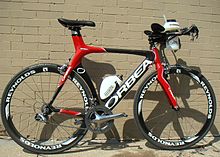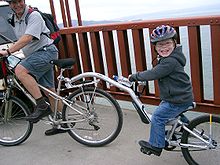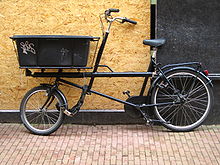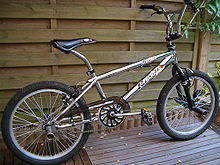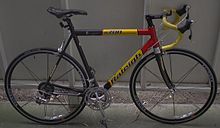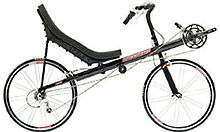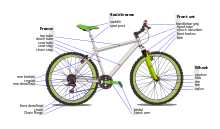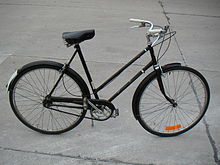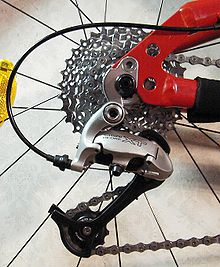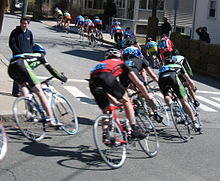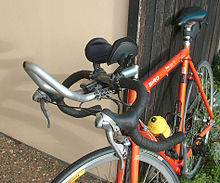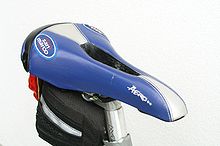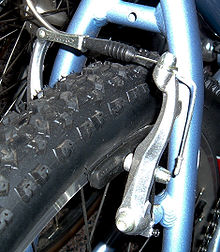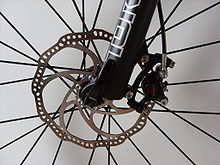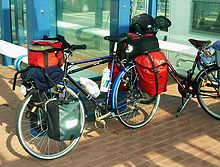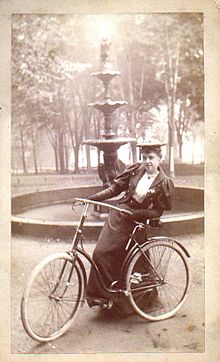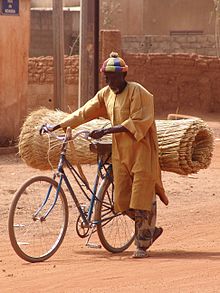- Outline of bicycles
-
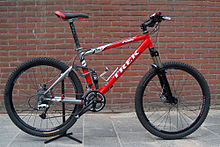 This mountain bicycle features oversized tires, a full-suspension frame, two disc brakes and handlebars oriented perpendicular to the bike's axis
This mountain bicycle features oversized tires, a full-suspension frame, two disc brakes and handlebars oriented perpendicular to the bike's axis
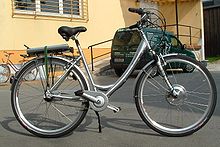 A European city bike, an example of a bicycle designed for transportation. Also an example of a motorized bicycle.
A European city bike, an example of a bicycle designed for transportation. Also an example of a motorized bicycle. A BMX bike, an example of a bicycle designed for sport
A BMX bike, an example of a bicycle designed for sport A racing upright bicycle
A racing upright bicycle A Triumph with a step-through frame.
A Triumph with a step-through frame.
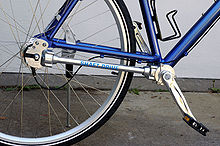 A bicycle with shaft drive instead of a chain
A bicycle with shaft drive instead of a chain A front disc brake, mounted to the fork and hub
A front disc brake, mounted to the fork and hub
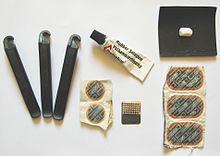 Puncture repair kit with tire levers, sandpaper to clean off an area of the inner tube around the puncture, a tube of rubber solution (vulcanizing fluid), round and oval patches, a metal grater and piece of chalk to make chalk powder (to dust over excess rubber solution). Kits often also include a wax crayon to mark the puncture location.
Puncture repair kit with tire levers, sandpaper to clean off an area of the inner tube around the puncture, a tube of rubber solution (vulcanizing fluid), round and oval patches, a metal grater and piece of chalk to make chalk powder (to dust over excess rubber solution). Kits often also include a wax crayon to mark the puncture location.
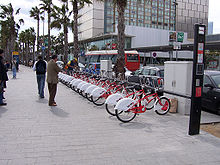 A bike-sharing station in Barcelona
A bike-sharing station in Barcelona
The following outline is provided as an overview of and topical guide to bicycles:
Bicycle – pedal-driven, human-powered, single-track vehicle, having two wheels attached to a frame, one behind the other. A person who rides a bicycle is called a cyclist or a bicyclist, and the activity is called cycling. Also known as a bike, push bike or cycle.
Contents
History
Main article: History of the bicycleKey developments
- draisine, dandy horse, or Laufmaschine
- boneshaker
- velocipede
- Penny-farthing, high wheel, high wheeler, or ordinary
- safety bicycle
People
Early developers
- Karl von Drais
- Pierre Michaux
- Pierre Lallement
- Thomas McCall
- J. K. Starley
- Albert Augustus Pope
- Mikael Pedersen
Mountain bike developers
Racing authors
- Eddie Borysewicz
- Greg LeMond
- Davis Phinney
- Connie Carpenter
- Lance Armstrong
Other authors
Organizations
- cycling club
- League of American Bicyclists
- Mountain Bike Hall of Fame
- National Off-Road Bicycle Association
- Union Cycliste Internationale
- USA Cycling
- World Human Powered Vehicle Association
Technical aspects
The bicycle has undergone continual adaptation and improvement since its inception. These innovations have continued with the advent of modern materials and computer-aided design, allowing for a proliferation of specialized bicycle types.
Uses
Bicycles have been and are employed for many uses:
- Utility: bicycle commuting and utility cycling
- Work: mail delivery, paramedics, police, couriering, and general delivery.
- Recreation: bicycle touring, mountain biking, BMX and physical fitness.
- Racing: track racing, criterium, roller racing and time trial to multi-stage events like the Tour of California, Giro d'Italia, the Tour de France, the Vuelta a España, the Volta a Portugal, among others.
- Military: scouting, troop movement, supply of provisions, and patrol. See bicycle infantry.
- Show: entertainment and performance, e.g. circus clowns. Used as instrument by Frank Zappa.
Types
Main article: List of bicycle typesBicycles can be categorized in different ways: e.g. by function, by number of riders, by general construction, by gearing or by means of propulsion. The more common types include utility bicycles, mountain bicycles, racing bicycles, touring bicycles, hybrid bicycles, cruiser bicycles, and BMX Bikes. Less common are tandems, lowriders, tall bikes, fixed gear, folding models and recumbents (one of which was used to set the IHPVA Hour record).
Unicycles, tricycles and quadracycles are not strictly bicycles, as they have respectively one, three and four wheels, but are often referred to informally as "bikes".
Dynamics
Main article: Bicycle and motorcycle dynamics- countersteering
- stoppie
- Two-mass-skate bicycle
- wheelie
Performance
Main article: Bicycle performanceGeometry
Main article: Bicycle and motorcycle geometryConstruction and parts
In its early years, bicycle construction drew on pre-existing technologies. More recently, bicycle technology has in turn contributed ideas in both old and new areas.
For details on specific bicycle parts, see list of bicycle parts and category:bicycle parts.
Frame
Main article: Bicycle frameThe great majority of today's bicycles have a frame with upright seating which looks much like the first chain-driven bike.
- step-through frame
- mixte
- tandem bicycle
- sociable
- recumbent bicycle
- bamboo bicycle
- folding bicycle
- portable bicycle
Brands and makers of unusual frames:
- Humber (bicycle)
- Pedersen bicycle
- Zipp 2001
Drivetrain and gearing
Main article: Bicycle drivetrain systemsPower collection
- bottom bracket
- cranks
- pedals
- treadle
Power transmission
Power modification
Power application
Steering and seating
Brakes
Main article: Bicycle brakeSuspension
Main article: Bicycle suspensionWheels
Main article: Bicycle wheel- wheelset
- bicycle tire
- slick tire
- knobby tire
- tubular tire
- tubes
- Valve stem
Accessories, repairs, and tools
- mudguard, or fender
- chainguard
- kick stand
- bike lock
- bicycle bell
- bicycle basket
- luggage carrier
- pannier
- child seats
- toe-clips and toestraps
- clipless pedals
- cyclocomputer and cycling power meter
- bicycle lighting and bicycle reflector
- bottle cages and water bottles
- Bicycle helmet
- bicycle pump and CO2 inflator
- tire lever
Standards
A number of formal and industry standards exist for bicycle components to help make spare parts exchangeable and to maintain a minimum product safety.
The International Organization for Standardization, ISO, has a special technical committee for cycles, TC149, that has the following scope: "Standardization in the field of cycles, their components and accessories with particular reference to terminology, testing methods and requirements for performance and safety, and interchangeability."
CEN, European Committee for Standardisation, also has a specific Technical Committee, TC333, that defines European standards for cycles. Their mandate states that EN cycle standards shall harmonize with ISO standards. Some CEN cycle standards were developed before ISO published their standards, leading to strong European influences in this area. European cycle standards tend to describe minimum safety requirements, while ISO standards have historically harmonized parts geometry. The TC149 ISO bicycle committee, including the TC149/SC1 ("Cycles and major sub-assemblies") subcommittee, has published the following standards:
- ISO 4210 Cycles—Safety requirements for bicycles
- ISO 6692 Cycles—Marking of cycle components
- ISO 6695 Cycles—Pedal axle and crank assembly with square end fitting—Assembly dimensions
- ISO 6696 Cycles—Screw threads used in bottom bracket assemblies
- ISO 6697 Cycles—Hubs and freewheels—Assembly dimensions
- ISO 6698 Cycles—Screw threads used to assemble freewheels on bicycle hubs
- ISO 6699 Cycles—Stem and handlebar bend—Assembly dimensions
- ISO 6701 Cycles—External dimensions of spoke nipples
- ISO 6742 Cycles—Lighting and retro-reflective devices—Photometric and physical requirements
- ISO 8090 Cycles—Terminology (same as BS 6102-4)
- ISO 8098 Cycles—Safety requirements for bicycles for young children
- ISO 8488 Cycles—Screw threads used to assemble head fittings on bicycle forks
- ISO 8562 Cycles—Stem wedge angle
- ISO 10230 Cycles—Splined hub and sprocket—Mating dimensions
- ISO 11243 Cycles—Luggage carriers for bicycles—Concepts, classification and testing
Other ISO Technical Committees have published various cycle relevant standards, for example:
- ISO 5775 Bicycle tire and rim designations
- ISO 9633 Cycle chains—Characteristics and test methods
Published cycle standards from CEN TC333 include:
- EN 14764 City and trekking bicycles – Safety requirements and test methods
- EN 14765 Bicycles for young children – Safety requirements and test methods
- EN 14766 Mountain-bicycles – Safety requirements and test methods
- EN 14781 Racing bicycles – Safety requirements and test methods
- EN 14872 Bicycles – Accessories for bicycles – Luggage carriers
- EN 15496 Cycles – Requirements and test methods for cycle locks
Yet to be approved cycle standards from CEN TC333:
- EN 15194 Cycles—Electrically power assisted cycles (EPAC bicycle)
- EN 15532 Cycles—Terminology
- 00333011 Cycles – Bicycles trailers – safety requirements and test methods
Social and historical aspects
The bicycle has had a considerable effect on human society, in both the cultural and industrial realms.
- List of films about bicycles and cycling
In daily life
Female emancipation
Economic implications
- Bicycle industry
- List of bicycle manufacturing companies
- ball bearings
- washers
- sprockets
- mass production
- planned obsolescence
- conspicuous consumption
- jock strap
- World Bicycle Relief
Legal requirements
The Vienna Convention on Road Traffic of the United Nations considers a bicycle to be a vehicle, and a person controlling a bicycle (whether actually riding or not) is considered an operator.
See also
- Cycling – use of bicycles
General
- Bicycle commuting
- Bicycle lighting
- Bicycle lock
- Bicycle locker
- Bicycle safety
- Bicycle tools
- List of bicycle and human powered vehicle museums
Special uses and related vehicle types
- Art bike
- Balance bicycle
- Beach cruiser
- Belt-driven bicycle
- Bicycle trailer
- Billboard bicycle
- Bixi
- Boda-boda
- Clown bicycle
- Conference Bike
- Cycle rickshaw
- Faired bicycle
- Folding bicycle
- Freight bicycle
- Infantry bicycle
- Monowheel
- Party Bike
- Portable bicycle
- Prone bicycle
- Quadracycle
- Racing bicycle
- Road bicycle
- Rowing cycle
- Shaft-driven bicycle
- Small wheel bicycle
- Tall bike
- Tandem bicycle
- Trailer bike
- Treadle bicycle
- Tricycle
- Utility cycling
- Unicycle
- Velocipede
- Workbike
Other
Human-powered transport Land Pedal powerBicycle · Bicycle trailer · Cycle rickshaw · Freight bicycle · Mountain bike · Party Bike · Quadracycle · Recumbent bicycle · Road bike · Tandem bicycle · Trailer bike · Tricycle · Trikke · Unicycle · Velocar · Velocipede · VelomobileHand-powerRow-actionRowing cyclesFoot powerPushed/pulledBaby transport · Baggage cart · Gurney · Handcart · Hand truck · Pulled rickshaw · Shopping cart · Stairclimber · WheelbarrowCarriedWater Snow and ice Alpine touring skis · Crampons · Cross-country skis · Ice skates · Kicksled · Snowshoes · Telemark skis · Snowboard · SledAir Outlines General reference · Culture and the arts · Geography and places · Health and fitness · History and events · Mathematics and logic · Natural and physical sciences · People and self · Philosophy and thinking · Religion and belief systems · Society and social sciences · Technology and applied sciencesCategories:- Cycling
- Sustainable technologies
- Appropriate technology
- Bicycles
- Outlines
Wikimedia Foundation. 2010.

